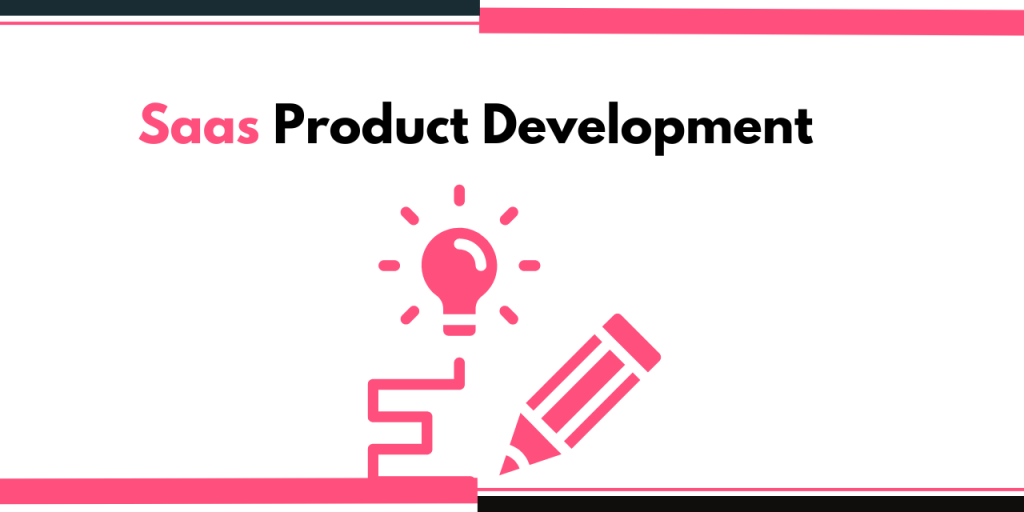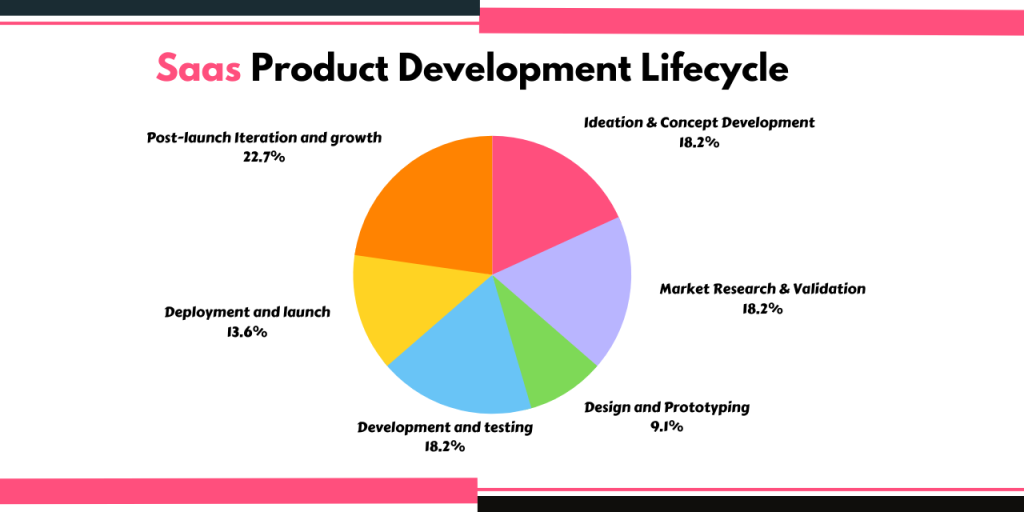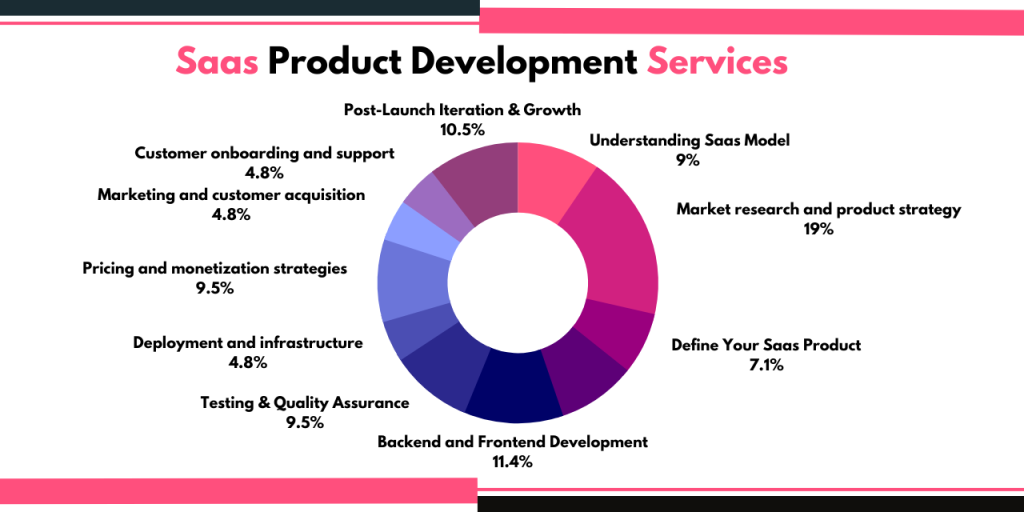In today’s rapidly evolving business landscape, Saas emerged as a game-changer that revolutionised software to deliver easy and accessible solutions for business. Whether you’re a startup or an established organisation, you need to develop and plan to launch a successful SaaS product that requires a well-executed approach.
This comprehensive guide provides you with a step-by-step roadmap covering essential aspects of Saas product development. From the conceptualization to the launch stage- explore the key strategies that will help you with a market-ready saas solution. The guide will delve into various topics- including understanding the Saas model, market research & product development, post-launch iteration and growth.
It will also highlight the importance of user-centricity, scalability, security, and continuous improvement in the product development process. If you follow the insights and recommendations provided in this guide, you will get a comprehensive understanding of software as a service product development, its lifecycle and about its services.
With the help of knowledge and tools, you can prepare for your saas product development journey to get a successful launch. So, let’s unlock the potential of SaaS products & create a cutting-edge and impactful Saas solution. Let’s first understand the basics before we delve into the saas product development lifecycle and know saas product development services.
Listen to this Podcast to Learn more about Saas Product Development
Saas Product Development
This development involves creating a cloud-based software application that can be accessed and utilised over the Internet. It encompasses market research, product strategy, UI/UX design, agile development, thorough testing, & scalable deployment. Cloud computing offers businesses and their user’s flexibility, scalability, and cost-effectiveness through SaaS products.
In order to meet changing customer and market demands, the process must be iterated and enhanced continuously. Therefore, in SaaS product development, the goal is to provide users with seamless experiences and address specific pain points in different industries. While saas application development focuses on streamlining the business’s development lifecycle by providing them with the resources, and infrastructure needed to build, deploy, and maintain high-performing apps.
Saas Product Development Lifecycle
The Saas product development lifecycle outlines the stages where you can create and launch a successful Software as a Service (SaaS) product. This lifecycle provides a structured framework that helps businesses navigate the complexities of product development while ensuring a high-quality, market-ready solution. Here’s an overview of the critical stages in the saas product lifecycle:
-
Ideation & Concept Development
You need to Identify market needs and opportunities and generate new ideas or refine product ideas. In this stage, you define the product vision, goals, and unique value proposition. Also, conduct initial market research and validation to assess the product’s viability.
-
Market Research & Validation
You need to conduct an in-depth market analysis to understand the target audience, competition, and industry trends. As well as validate the product concept through user feedback, surveys, and interviews. Also, refine the product concept based on market insights and feedback. -
Design and Prototyping
Create wireframes, user interface (UI) designs and user flows and develop prototypes to visualize the product’s functionality and user experience (UX). Also, alter the design to gather user feedback to ensure the creation of an intuitive and user-friendly interface. -
Development and testing
In this phase, you work on the appropriate technology of the product. Develop the backend infrastructure, frontend interfaces, & required features. You can Implement robust testing methodologies, including functional, performance, and security testing. Continuously iterate & refine the product based on testing results and user feedback for saas product development.
-
Deployment and launch
The deployment stage refers to choosing a hosting environment (cloud or on-premises) that aligns with the product’s requirements. Configure and deploy the SaaS product. Implement essential security measures and ensure scalability to handle user demand. Plan the product launch, including marketing campaigns, promotional activities, and user onboarding strategies. -
Post-launch Iteration and growth
Finally, collect and analyze user feedback in the post-iteration stage to identify areas for improvement. You can Prioritize and implement updates, new features, and bug fixes based on user needs. Continuously monitor performance, security, and user engagement metrics. Develop a roadmap for future enhancements and expansion to drive product growth.
Saas Product Development Services
Software as a Service (SaaS) has gained immense popularity by offering businesses- the ability to access and use software applications over the Internet, eliminating the need for complex infrastructure and maintenance. However, successfully developing and launching a SaaS product requires a well-thought-out approach. This comprehensive guide will take you through the primary steps- involved in SaaS product development, from concept to launch.
-
Understanding Saas Model
The Software as a Service (SaaS) model has revolutionized the software industry by offering software solutions- as a service over the Internet. SaaS provides numerous benefits, including accessibility from any device with an internet connection, automatic updates, and scalability to meet varying user demands. It differs from traditional software delivery models, such as on-premises installations or perpetual licensing, as it eliminates the need for upfront investments in hardware and software licenses. The market potential for SaaS products is vast, driven by the increasing demand for flexible, cost-effective, and easy-to-use software solutions across industries. Businesses are adopting SaaS to streamline operations, enhance productivity, and reduce IT infrastructure complexities, making it a highly sought-after software delivery model. -
Market research and product strategy
Effective market research is crucial for developing a successful SaaS product. By conducting a thorough market analysis, a business can identify its target audience and understand its needs, preferences, and pain points. This knowledge helps define a clear product vision, goals, and a unique value proposition that sets the product apart from its competitors. Creating a comprehensive product roadmap and strategy enables businesses to prioritize features, plan for iterative development, and align their product with market demands.
-
Define Your Saas Product
Defining your SaaS product development involves translating market needs and customer requirements into features and functionalities. By conducting thorough market research and understanding customer pain points- you need to address business needs effectively. Creating a product roadmap helps you envision the product’s development journey and put features based on their importance and impact.
Developing a Minimum Viable Product (MVP) allows businesses to validate their concept and gather early feedback from users, enabling iterative improvements and reducing the risk of building unnecessary features. This strategic approach ensures that the final SaaS product meets market demands and delivers value to customers.
-
Design User Experience (UX)
Designing an intuitive and seamless user experience is essential for SaaS products. It involves creating user interfaces that are visually appealing, easy to navigate, and aligned with user expectations. Having wireframes, prototypes, and user flows helps visualize the product’s design and functionality. Conducting user testing and incorporating feedback allows for iterative improvements to enhance the overall user experience and optimize user engagement. -
Backend and frontend development
Selecting appropriate technologies and frameworks is crucial for building scalable and secure businesses for Saas product development. The backend development focuses on creating a robust architecture that can handle increased user demand, ensuring data security and efficient management. Frontend development involves translating designs into functional and responsive user interfaces. Implementing the features like- user management, data storage, and integrations enhance the product’s capabilities and usability. -
Testing & Quality Assurance
Comprehensive testing ensures that the SaaS product is reliable, secure, and performs optimally. Planning and executing various testing methodologies, such as functional, performance, and security testing, help identify and address any issues or bugs. Automated testing and continuous integration streamline the testing process, ensuring high-quality & error-free product releases. -
Deployment and infrastructure
Choosing the appropriate hosting environment, whether cloud-based or on-premises, it’s a critical decision in Saas product development. Cloud hosting offers scalability, flexibility, and reduced infrastructure maintenance, while on-premises hosting provides more control over data and security. Configuring and deploying the SaaS product helps you scale the infrastructure to accommodate growing user demand and ensures optimal performance and availability. -
Pricing and monetization strategies
Selecting an accurate pricing model and subscription plans is essential for revenue generation. Businesses should analyze their target market, competitors, and value proposition to set competitive yet profitable pricing. Implementing payment gateways and billing systems streamlines revenue collection. Regular analysis of revenue streams helps optimize monetization strategies, such as upselling, cross-selling, or introducing tiered pricing, to maximize profitability. -
Marketing and customer acquisition
A well-crafted marketing strategy is vital for attracting and acquiring customers. Building an engaging website and optimized landing pages enable effective lead generation. Leveraging digital marketing channels, such as content marketing, social media, and search engine optimization, helps reach the target audience. Implementing user acquisition tactics, such as referral programs or strategic partnerships, further boosts customer acquisition and market penetration. -
Customer onboarding and support
Designing an efficient onboarding process ensures a smooth user experience for new customers. Providing comprehensive customer support and training helps users navigate the product and resolve any issues they may encounter. Collecting and analyzing customer feedback allows for continuous improvement, enabling businesses to refine their product and enhance customer satisfaction. By leveraging these SaaS product development services, the company should create a market-ready and successful SaaS product that caters to its target audience’s needs while achieving sustainable growth and profitability. -
Post-Launch Iteration & Growth
Post-launch iteration and growth are crucial for the long-term success of a SaaS product. Analyzing user feedback and data provides valuable insights into user preferences, pain points, and areas for improvement. One should actively listen to their customers- collect data, businesses can identify and prioritize product enhancements and updates. Continuously iterating and releasing new features based on user needs ensures that the product remains competitive and aligned with evolving market demands. Additionally, scaling customer acquisition and retention strategies helps you expand the user base and maximise customer lifetime value. This iterative and growth-focused approach enables businesses to create a dynamic and customer-centric SaaS product that drives ongoing user satisfaction and business growth.
Read More
How Web Development Services Will Transform Your Online Business
Outsourcing Software Development Basics You Need To Know
Conclusion
Developing and launching a successful SaaS product requires a well-defined roadmap and careful execution at each stage. You can follow this comprehensive guide & get equipped with the knowledge and understanding needed to navigate the complexities of SaaS product development, from conceptualization to a successful launch. Remember, the key to long-term success lies in continuous improvement, adapting to market needs, and delivering exceptional value for your customer.




